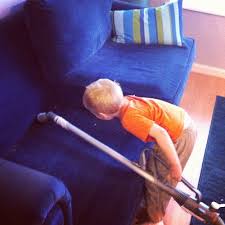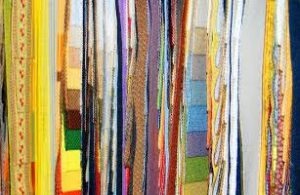Fabric Furniture Care
You’ve just made that investment into a quality piece of furniture and now need to care for it to ensure it will give you years of lasting use and joy. First and foremost you need to learn how to provide proper fabric furniture care. Most people will think care is just vacuuming the seat, arms, under the cushions and between the crevices to remove dirt, dust, pet and food remnants.
However, some fabrics may need more advanced care and cleaning to keep the piece looking and feeling its best. You may also have to deal with scrapes and stains. Before following any of the care instructions below, please adhere to any care instructions provided directly with you furniture selection. Let’s look at fabric furniture care and see how it can be maintained successfully.

Cleaning Codes
Many manufacturers use codes on their furniture labels to indicate the best method of cleaning your new selection of furniture. Care labels are normally located under a seat cushion, on the base of the selection under the cushions or on the bottom of the furniture. Please follow the manufacturer’s recommendation for providing the best care of your furniture. Here is a list of commonly used codes and what they mean (1):
| Code | Meaning |
| DC | Dry Clean Only |
| E | Use the Millennium Leather Care Kit |
| HW | Washing by hand rather than by using a machine. |
| N | Use the Millennium Leather Care Kit |
| N Fbr | Natural Fiber Rugs – Blot spills up immediately with a clean white cloth or plain paper towel. Dab at spots with a mild solution of one teaspoon of mild detergent with one teaspoon of white vinegar in a quart of warm water. Do not saturate. |
| NA | Not Applicable to a Cleaning Code |
| S | Clean only with dry cleaning solvent. Do not saturate. Do not use water. Pile fabrics may require brushing to restore appearance. Cushion covers should not be removed and dry cleaned. |
| SW | Spot clean with upholstery shampoo, foam from a mild detergent, or mild dry cleaning solvent. Do not saturate with liquid. Pile fabrics may require brushing to restore appearance. Cushion covers should not be removed and dry cleaned. |
| W | Clean only with water-based shampoo or foam upholstery cleaner. Do not over wet. Do not use solvents to spot clean. Pile fabrics may require brushing to restore appearance. Cushion covers should not be removed and laundered. |
| WASH | Machine wash separately in cold water, gentle cycle with mild detergent. Do not use bleach. Tumble dry at low setting or line dry. |
| WOOL | Tufted Wool Rugs – Blot spills up immediately with a clean white cloth or plain paper towel. There are no cleaning solutions listed. |
| WS | Spot clean with upholstery shampoo, foam from a mild detergent, or mild dry cleaning solvent. Do not saturate with liquid. Pile fabrics may require brushing to restore appearance. Cushion covers should not be removed and dry cleaned. |
| X | Do not clean with either water- or solvent-based cleaner. Use vacuuming or light brushing only. |
Fabric (Non-Leather) Materials
General Considerations
Important Note: please read and follow the cleaning and maintenance instructions that come from the manufacturer of your furniture before using any cleaning product.
- Not all upholstery fabrics wear or clean the same. Make sure you understand the type of fabric you have and any special considerations you need to take into account before cleaning.
- Keep your furniture in a temperature controlled area and do not place directly next to a heating or cooling unit.
- Do not use furniture crafted for indoor use outdoors as the fabric cannot withstand temperature, humidity, animal and direct sunlight. Buy furniture rated for outdoor use for your outdoor needs.
Normal Cleaning and Maintenance
Vacuuming
 Check to make sure there are no loose objects in the cracks of the furniture to get stuck in vacuum.
Check to make sure there are no loose objects in the cracks of the furniture to get stuck in vacuum.- Remove loose buttons or threads that can get caught or pull during a vacuum.
- Clip loose threads to avoid further pull from vacuuming.
- Use a soft brush attachment that is clean and free of any residues. Most vacuums have a crevice tool to use in the cracks of the furniture. Perhaps designate the attachment as furniture only.
- Vacuum regularly to avoid soil, dirt, lint and pet hair build-up.
General Cleaning
- Always test your cleaning solution on a hidden portion of the furniture first in case there is discoloration or other damage.
- Note if there are specific cleaning instructions that are on your furniture label or documentation that came with the furniture. (We keep all our product manuals in a special folder that we can easily reference when needed.)
- Use a lint or pet brush to remove lint and pet hair from the furniture. If you don’t have one, loop a piece of masking tape around your hand and roll it around the furniture to trap loose hair and lint.
- Use a clean cloth or sponge to quickly blot or soak up spills. Never rub a spill to avoid doing further damage.
- If you anticipate frequent soiling due to children or pets, most manufacturers offer a soil retardant (Teflon or Scotchgard) that is applied to fabric to help resist staining and damage from accidental spills and dirt. They usually come with warranties in case the spill causes a stain that cannot be removed with gentle wiping. Sometimes the consumer can purchase and apply a soil retardant themselves. (Our recommendations would be to have it professionally applied with a warranty.)
- Remove all cleaning solution used to avoid residual damage to avoid attracting more dirt.
- Turn your cushions over, if possible, and fluff them to keep an even wear and extend the life of your seating.
Scuffs, Scrapes and Stains
- Do NOT soak fabric or furniture in upholstery cleaning solutions.
- Significant spills or soiling may warrant advanced cleaning beyond blotting. Check your furniture label to see if slipcovers or cushion covers can be removed and washed. If so, check the cushion material to see if it needs cleaning attention too.
- Stains that cannot be easily blotted dry may need a deep cleaning. Follow your furniture instructions or hire a professional that is knowledge of your fabric, color, patterns, your stain problems and cleaning chemicals that are acceptable to use on your specific furniture piece.
- Deep cleanings are recommended every year or two to ensure longevity of your selection.
Fabric Specific Care Information
According to Better Homes and Gardens the following fabrics may have specific cleaning and care needs. (2) Identify the type of upholstery you have on your piece of furniture and look for specific care below.
 Cotton fabrics are commonly used for upholstery, however their durability depends on the weave and finish. If a cotton fabric has been pre-washed (as is often the case with slipcovers), then it should be fine to clean with soap and water, however, it is always wise to check the manufacturer’s recommended cleaning method. Cotton fabrics will fade in direct sunlight.
Cotton fabrics are commonly used for upholstery, however their durability depends on the weave and finish. If a cotton fabric has been pre-washed (as is often the case with slipcovers), then it should be fine to clean with soap and water, however, it is always wise to check the manufacturer’s recommended cleaning method. Cotton fabrics will fade in direct sunlight.- Cotton Blends can be a sturdy, family-friendly product. A stain-resistant finish should be applied for everyday use.
- Canvas can be a good choice for family rooms because it is especially durable. The flat surface shows grime and holds dirt particles, however, so frequent vacuuming is a must. Pre-washing before fabrication can make it easy to pop smaller canvas slipcovers into the washing machine for cleaning.
- Damask weaves are formal. They should be brushed and vacuumed gently to avoid breaking threads.
- Linen is best suited for formal living rooms or adult areas. Have soiled pieces professionally cleaned. Keep linen out of direct exposure to sunlight whenever possible.
- Microfibers are a new addition to home furnishings. Offering a soft hand and a vast color range, they also resist most stains and can easily be cleaned with soap and water. This fabric is a good choice for households with children.
- Wools and wool blends are sturdy and durable to use for sofas and chairs. Blends can be spot cleaned when necessary. Check manufacturer’s recommended cleaning method.
- Silk is a delicate fabric only suitable for adult areas, such as formal living rooms. It must be professionally cleaned if soiled. Keep silks out of direct exposure to sunlight whenever possible.
- Sunbrella fabrics are being seen both indoors and out. They offer superior resistance to stains and fading which makes them a good choice for busy families.
- Leather furniture should be gently vacuumed and damp wiped as needed, using as little water as possible. Clean with leather conditioner or saddle soap, buffing thoroughly to remove residue.
- Suede can be vacuumed with a soft brush attachment. Use only made-for-suede leather cleaners. Remove small spots with art gum erasers. Never clean with water.
Conclusion
Don’t shy away from choosing a fabric of choice that makes you happy sitting on the piece or for accessorizing your decor. Identify your upholstery fabric and learn the specifics of caring for your furniture piece. Proper cleaning, whether done in home or by a professional, will keep your furniture selection(s) looking great and feeling comfortable for years to come.
Wishing you cleaning and maintenance success for your furniture choices!
References:
- (1) Ashley Furniture Industries – Cleaning Codes
- (2) Better Homes and Gardens – Upholstered Furnishings Care

